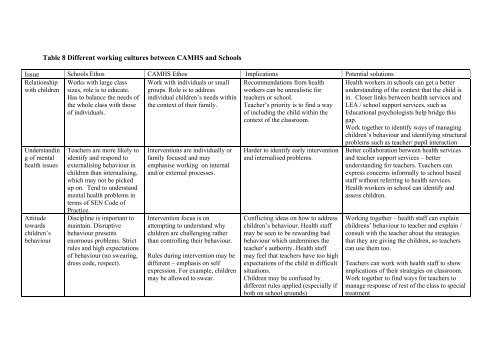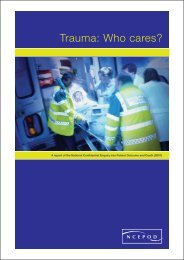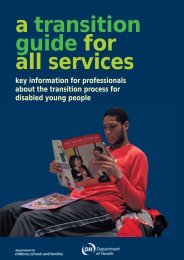(CAMHS) and Schools - London Health Programmes
(CAMHS) and Schools - London Health Programmes
(CAMHS) and Schools - London Health Programmes
You also want an ePaper? Increase the reach of your titles
YUMPU automatically turns print PDFs into web optimized ePapers that Google loves.
Table 8 Different working cultures between <strong>CAMHS</strong> <strong>and</strong> <strong>Schools</strong><br />
Issue <strong>Schools</strong> Ethos <strong>CAMHS</strong> Ethos Implications Potential solutions<br />
Relationship<br />
with children<br />
Underst<strong>and</strong>in<br />
g of mental<br />
health issues<br />
Attitude<br />
towards<br />
children’s<br />
behaviour<br />
Works with large class<br />
sizes, role is to educate.<br />
Has to balance the needs of<br />
the whole class with those<br />
of individuals.<br />
Teachers are more likely to<br />
identify <strong>and</strong> respond to<br />
externalising behaviour in<br />
children than internalising,<br />
which may not be picked<br />
up on. Tend to underst<strong>and</strong><br />
mental health problems in<br />
terms of SEN Code of<br />
Practice.<br />
Discipline is important to<br />
maintain. Disruptive<br />
behaviour presents<br />
enormous problems. Strict<br />
rules <strong>and</strong> high expectations<br />
of behaviour (no swearing,<br />
dress code, respect).<br />
Work with individuals or small<br />
groups. Role is to address<br />
individual children’s needs within<br />
the context of their family.<br />
Interventions are individually or<br />
family focused <strong>and</strong> may<br />
emphasise working on internal<br />
<strong>and</strong>/or external processes.<br />
Intervention focus is on<br />
attempting to underst<strong>and</strong> why<br />
children are challenging rather<br />
than controlling their behaviour.<br />
Rules during intervention may be<br />
different – emphasis on self<br />
expression. For example, children<br />
may be allowed to swear.<br />
Recommendations from health<br />
workers can be unrealistic for<br />
teachers or school.<br />
Teacher’s priority is to find a way<br />
of including the child within the<br />
context of the classroom.<br />
Harder to identify early intervention<br />
<strong>and</strong> internalised problems.<br />
Conflicting ideas on how to address<br />
children’s behaviour. <strong>Health</strong> staff<br />
may be seen to be rewarding bad<br />
behaviour which undermines the<br />
teacher’s authority. <strong>Health</strong> staff<br />
may feel that teachers have too high<br />
expectations of the child in difficult<br />
situations.<br />
Children may be confused by<br />
different rules applied (especially if<br />
both on school grounds)<br />
<strong>Health</strong> workers in schools can get a better<br />
underst<strong>and</strong>ing of the context that the child is<br />
in. Closer links between health services <strong>and</strong><br />
LEA / school support services, such as<br />
Educational psychologists help bridge this<br />
gap.<br />
Work together to identify ways of managing<br />
children’s behaviour <strong>and</strong> identifying structural<br />
problems such as teacher/ pupil interaction<br />
Better collaboration between health services<br />
<strong>and</strong> teacher support services – better<br />
underst<strong>and</strong>ing for teachers. Teachers can<br />
express concerns informally to school based<br />
staff without referring to health services.<br />
<strong>Health</strong> workers in school can identify <strong>and</strong><br />
assess children.<br />
Working together – health staff can explain<br />
childrens’ behaviour to teacher <strong>and</strong> explain /<br />
consult with the teacher about the strategies<br />
that they are giving the children, so teachers<br />
can use them too.<br />
Teachers can work with health staff to show<br />
implications of their strategies on classroom.<br />
Work together to find ways for teachers to<br />
manage response of rest of the class to special<br />
treatment

















